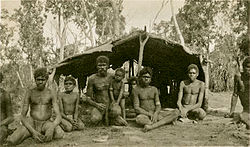IND/Initial Contact
Within two years, seventeen British convicts and soldiers had been murdered or wounded by Indigenous people, often when out on exploration or foraging trips. In 1790 date, Governor Phillip resolved to send out a punitive expedition:
| “ | [H]is excellency informed me that he had pitched upon me to execute the foregoing command. ... [W]e were, if practicable, to bring away two natives as prisoners; and to put to death ten; that we were to destroy all weapons of war but nothing else; that no hut was to be burned; that all women and children were to remain uninjured, not being comprehended within the scope of the order; that our operations were to be directed either by surprise or open force; that after we had made any prisoners, all communication, even with those natives with whom we were in habits of intercourse, was to be avoided, and none of them suffered to approach us. That we were to cut off and bring in the heads of the slain; for which purpose hatchets and bags would be furnished. And finally, that no signal of amity or invitation should be used in order to allure them to us; or if made on their part, to be answered by us: for that such conduct would be not only present treachery, but give them reason to distrust every future mark of peace and friendship on our part.
His excellency was now pleased to enter into the reasons which had induced him to adopt measures of such severity. He said that since our arrival in the country, no less than seventeen of our people had either been killed or wounded by the natives; that he looked upon the tribe known by the name of Bideegal, living on the before mentioned peninsula, and chiefly on the north arm of Botany Bay, to be the principal aggressors; that against this tribe he was determined to strike a decisive blow, in order, at once to convince them of our superiority and to infuse an universal terror, which might operate to prevent farther mischief. (Tench, 1788, pp. 207-208). |
” |
As more settlers arrived and British exploration and settlement spread, contact between Indigenous and British people increased. The British hunger for large tracts of land to graze stock and grow crops motivated harsh actions against Indigenous people. Murder, violence, rape, poisonings, capturing, physical removal, all occurred along the line of contact - the colonial frontier.
